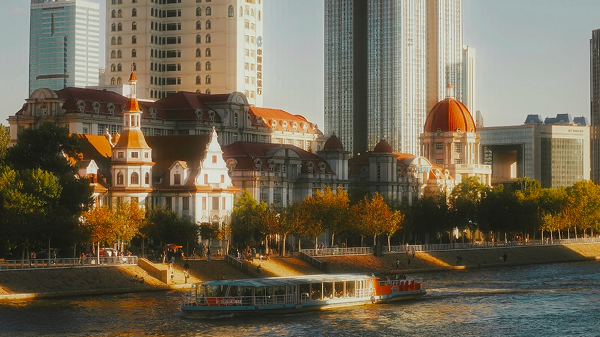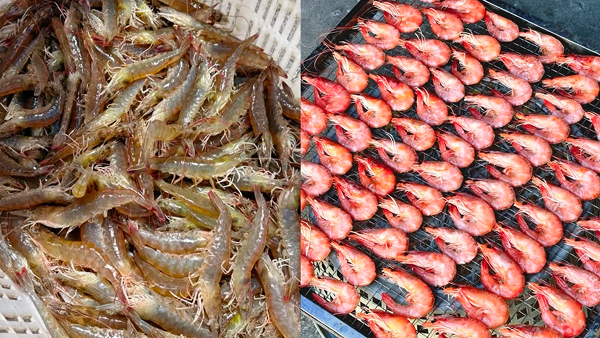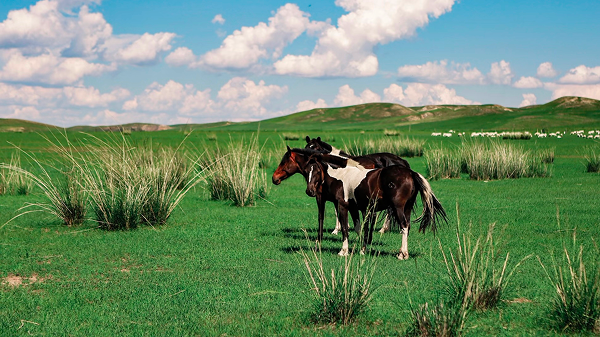The name Tianjin (天津) literally means “The Emperor’s Ferry.”
It’s one of those rare cities in China where the country’s imperial past and its modern maritime future meet at the same shore.
In 1404, during the second year of the Yongle Emperor’s reign in the Ming Dynasty, Tianjin was officially established as a garrison town. The character “Tian” (天) represents Heaven or the Emperor himself, while “Jin” (津) means ferry crossing. Legend says that Emperor Zhu Di once crossed the river here during his campaign for the throne—and in honor of his victory, he named this place Tianjin: the heavenly crossing.
If you’re wondering what Tianjin is known for, this is where it all begins—with rivers, trade, humor, and history flowing together.
1. A City Born of Water: The Origins of Tianjin
Water shaped Tianjin’s identity.
The city sits where five tributaries of the Hai River converge—the South Canal, Ziya River, Daqing River, Yongding River, and North Canal—earning Tianjin the poetic title: “The meeting of nine rivers, the key between river and sea.”

At the Sancha Estuary (三岔河口)—today near Jingang Bridge—this natural confluence gave birth to Tianjin’s earliest settlements. During the late Qing Dynasty, the city’s location made it the northern gateway of the Grand Canal, China’s ancient lifeline for trade.
But it was the year 1860 that truly changed everything. After the Second Opium War, Tianjin was forced open as a treaty port, inviting international settlements from Britain, France, Japan, and beyond. From that point on, the city transformed from a military ferry crossing to an international hub.
Today, Tianjin Port is the fourth largest comprehensive port in the world (after Shanghai, Ningbo, and Singapore) and China’s largest man-made deep-water port—a modern maritime symbol of a city born from rivers.
2. Tianjin Attractions: Where the Great Wall Meets the Sea
Most travelers don’t realize that the Great Wall of China extends beyond Beijing—it continues all the way to Tianjin’s eastern edge.
In Jizhou District, about 30 kilometers northeast of the city center, lies the Huangyaguan Great Wall (黄崖关长城). First built during the Qin Dynasty, it was rebuilt during the Ming Dynasty by the legendary general Qi Jiguang, who fortified this stretch against coastal invasions.

Today, this section forms part of the UNESCO World Heritage-listed Great Wall, known for its golden stone cliffs and sweeping views over the Bohai Gulf. Each brick here tells the story of Tianjin’s role as a border guardian—where empire met the ocean.
Bridge to Locals Tip:
Come early morning when mist rolls across the hills. The silence and view from Huangyaguan feel almost sacred.
3. Top Tianjin Tourist Attractions: Temples, Canals, and Mountains
Tianjin is a treasure chest of heritage, mixing religion, waterways, and mountain serenity.

Dule Temple (独乐寺) – First built in the Tang Dynasty, this temple is famous for its ancient wooden structure, delicate clay sculptures, and vibrant murals—known together as its “Three Perfections.”

The Grand Canal (京杭大运河) – Dug during the Sui Dynasty over a thousand years ago, the canal flows from Beijing through Tianjin all the way to Hangzhou. The Jiuxuan Lock (九宣闸) marks the oldest water gate in the Tianjin section, symbolizing the canal’s arrival in the city. Another, the Maquan Gate (马圈闸), stands as a quiet witness to how Tianjin grew from this ancient waterway.

Mount Panshan (盘山) – Located 15 km northwest of Jizhou, Panshan is often called the “First Mountain East of Beijing”. Emperors once visited here for meditation and landscape painting—it’s a perfect weekend escape today.
Bridge to Locals' Tips:
Pair your visit to Panshan with a countryside lunch—local farmers often host small home-style restaurants serving fresh tofu and mountain vegetables.
4. What Is Tianjin Known For? Culture in Color and Clay

Yangliuqing New Year Prints (杨柳青木版年画)
Dating back to the Ming Dynasty, these vivid woodblock-printed New Year paintings blend carving and hand coloring. Known as “South Taohuawu, North Yangliuqing”, they’re one of China’s most beloved folk arts and now a national intangible cultural heritage.
Clay Figurines of “Mudman Zhang” (泥人张)
Created by artist Zhang Mingshan during the Qing Dynasty’s Daoguang era, these hand-painted clay figures are so lifelike that Tianjin residents still call them “One of the City’s Four Wonders.”
Kites by Wei Yuantai
In 1914, local craftsman Wei Yuantai’s intricately designed kites won a gold medal at the Panama-Pacific International Exposition, bringing Tianjin’s folk artistry to global fame.
Crosstalk (相声)
Tianjin is the birthplace of China’s most famous form of stand-up comedy. The legendary Ma Sanli turned quick wit, wordplay, and sharp observation into an art form that still defines Tianjin humor today.
Martial Arts Legends
Tianjin produced Huo Yuanjia, founder of the Jingwu Athletic Association and symbol of Chinese martial pride, later immortalized in Bruce Lee’s Fist of Fury.
5. Tianjin Binhai and the City’s Modern Industry
Tianjin has always been a city that makes things. Today, Tianjin Binhai represents its economy thrives on what locals call the “1 + 3 + 4” model:
- 1 – Modern Manufacturing: High-end equipment, new materials, automotive, and IT.
- 3 – Port Logistics, Financial Services, and Cultural Tourism: the city’s three major economic pillars.
- 4 – Strategic Emerging Industries: Aerospace, aviation, petroleum chemistry, and new energy.
As part of the Belt and Road Initiative, Tianjin connects East Asia to Europe through both land and sea. Yet, it retains its friendly, down-to-earth character—where industrial power meets river-town charm.

6. The Heart of Tianjin: Humor, Humanity, and Everyday Life
Despite its scale and industry, Tianjin is famous for its humor, warmth, and inclusiveness.
Home to 53 ethnic groups, including a large Hui Muslim community, the city embraces diversity with a kind of quiet confidence. You’ll find Hui Muslim food markets, Catholic churches, and Buddhist temples standing within walking distance of each other—proof that coexistence is Tianjin’s quiet superpower.
Here, laughter is a local language.
Perhaps it’s the cold northern air, or the city’s riverside rhythm—but Tianjiners have turned storytelling, food, and craftsmanship into their way of life.
Why Travel in Tianjin with Bridge with Locals
Guidebooks can show you places, but Bridge to Locals introduces you to people.
Our mission is simple: to help travelers see Tianjin through its humor, art, and humanity.
With us, you can:
- Meet artisans who still handcraft Yangliuqing prints.
- Dine with a family by the Hai River over homemade seafood noodles.
- Visit Tianjin Binhai with a young local entrepreneur who shares what the city’s future looks like from the inside.
Because travel is more than sightseeing—it’s sharing life.








Leave a comment
This site is protected by hCaptcha and the hCaptcha Privacy Policy and Terms of Service apply.